Production and Characterization of Bacterial Ghost Vaccine against Neisseria meningitidis
Abstract
:1. Introduction
2. Materials and Methods
2.1. Bacterial Strain, Cultivation, and Storage Conditions
2.2. Determination of the Minimum Inhibitory Concentration (MIC) of Lactic Acid
2.3. Production of NmC-BG
2.4. Identification Tests
2.4.1. Detection of NmC-BG Formation by Scanning Electron Microscopy (SEM)
2.4.2. Agglutination Test
2.5. Analysis of Protein
2.5.1. Quantification of Released Proteins
2.5.2. Protein Gel Electrophoresis and Western Immunoblotting Analysis
Protein Gel Electrophoresis
Western Immunoblotting Analysis
2.6. Determination of DNA Content
2.6.1. Precipitation of Protein
2.6.2. Precipitation of DNA
2.6.3. DNA Gel Electrophoresis
2.7. Safety Assessment
2.7.1. Viability Test
2.7.2. Abnormal Toxicity Test
2.7.3. Bacterial Endotoxin Test
2.8. Immunogenicity Assessment
2.8.1. Induction of Antibodies Response
2.8.2. Assessment of Immune Response in Rat Groups Sera
2.8.3. Serum Bactericidal Activity (SBA)
2.9. Statistical Analysis
3. Results
3.1. Determination of Lactic Acid MIC Required to Develop NmC-BG Cell
3.2. Identification Tests
3.2.1. NmC-BG Evaluation by Scanning Electron Microscopy (SEM)
3.2.2. Agglutination Test Using Pastorex™ Meningitis Kit
3.3. Analysis of Protein
3.3.1. Quantification of Released Proteins
3.3.2. Protein Gel Electrophoresis and Western Immunoblotting Analysis
Protein Gel Electrophoresis
Western Immunoblotting Analysis
3.4. Determination of DNA Content
3.4.1. Quantification of DNA
3.4.2. DNA Gel Electrophoresis
3.5. Safety Assessment
3.5.1. Viability Test
3.5.2. Abnormal Toxicity Test
3.5.3. Bacterial Endotoxin Test
3.6. Assessment of Immune Response in Rats Sera
3.7. Bactericidal Activity
3.7.1. The Bactericidal Activity in Vaccinated Groups with NmC-BG
3.7.2. The Bactericidal Activity in Vaccinated Groups with Commercial Vaccine
3.7.3. The Bactericidal Activity in Vaccinated Groups NmC-BG versus Commercial Vaccine
4. Discussion
5. Conclusions
Supplementary Materials
Author Contributions
Funding
Institutional Review Board Statement
Data Availability Statement
Acknowledgments
Conflicts of Interest
References
- Pollard, A.; Bijker, E. A guide to vaccinology: From basic principles to new developments. Nat. Rev. Immunol. 2021, 21, 83–100. [Google Scholar] [CrossRef] [PubMed]
- Hajam, I.; Dar, P.; Won, G.; Lee, J. Bacterial ghosts as adjuvants: Mechanisms and potential. Vet. Res. 2017, 48, 37. [Google Scholar] [CrossRef] [PubMed] [Green Version]
- Langemann, T.; Koller, V.; Muhammad, A.; Kudela, P.; Mayr, U.; Lubitz, W. The bacterial ghost platform system. Bioeng. Bugs 2010, 1, 326–336. [Google Scholar] [CrossRef] [PubMed] [Green Version]
- Amara, A.; Salem-Bekhit, M.; Alanazi, F. Sponge-Like: A New Protocol for Preparing Bacterial Ghosts. Sci. World J. 2013, 2013, e545741. [Google Scholar] [CrossRef] [Green Version]
- Guo, X.; Liu, J.; Xiao, B. Evaluation of the damage of cell wall and cell membrane for various extracellular polymeric substance extractions of activated sludge. J. Biotechnol. 2014, 188, 130–135. [Google Scholar] [CrossRef]
- Rabea, S.; Salem-Bekhit, M.; Alanazi, F.; Yassin, A.; Moneib, N.; Hashem, A. A novel protocol for bacterial ghosts’ preparation using tween 80. Saudi Pharm. J. 2018, 26, 232–237. [Google Scholar] [CrossRef]
- Chassaing, B.; Koren, O.; Goodrich, J.; Poole, A.; Srinivasan, S.; Ley, R.; Gewirtz, A. Dietary emulsifiers impact the mouse gut microbiota promoting colitis and metabolic syndrome. Nature 2015, 519, 92–96. [Google Scholar] [CrossRef] [Green Version]
- Nielsen, C.; Kjems, J.; Mygind, T.; Snabe, T.; Meyer, R. Effects of Tween 80 on Growth and Biofilm Formation in Laboratory Media. Front. Microbiol. 2016, 7, 1878. [Google Scholar] [CrossRef]
- Alakomi, H.-L.; Skyttä, E.; Saarela, M.; Mattila-Sandholm, T.; Latva-Kala, K.; Helander, I. Lactic Acid Permeabilizes Gram-Negative Bacteria by Disrupting the Outer Membrane. Appl. Environ. Microbiol. 2000, 66, 2001–2005. [Google Scholar] [CrossRef] [Green Version]
- Meningitis, (n.d.). Available online: https://www.who.int/westernpacific/health-topics/meningitis (accessed on 12 February 2022).
- Joshi, V.; Bajaj, I.; Survase, S.; Singhal, R.; Kennedy, J. Meningococcal polysaccharide vaccines: A review. Carbohydr. Polym. 2009, 75, 553–565. [Google Scholar] [CrossRef]
- WHO. Meningococcal Meningitis, WHO|Regional Office for Africa. (n.d.). 2021. Available online: https://www.afro.who.int/health-topics/meningococcal-meningitis (accessed on 12 February 2022).
- Frasch, C.; Bash, M. Neisseria meningitidis Vaccines, Landes Bioscience. 2013. Available online: https://www.ncbi.nlm.nih.gov/books/NBK6030/ (accessed on 21 May 2022).
- Fernandez, K.; Lingani, C.; Aderinola, O.; Goumbi, K.; Bicaba, B.; Edea, Z.; Glèlè, C.; Sarkodie, B.; Tamekloe, A.; Ngomba, A.; et al. Meningococcal Meningitis Outbreaks in the African Meningitis Belt After Meningococcal Serogroup A Conjugate Vaccine Introduction, 2011–2017. J. Infect. Dis. 2019, 220, S225–S232. [Google Scholar] [CrossRef] [PubMed]
- Meningitis Lab Manual: ID and Characterization of Neisseria|CDC. 2021. Available online: https://www.cdc.gov/meningitis/lab-manual/chpt07-id-characterization-nm.html (accessed on 14 June 2021).
- M02Ed13|Performance Standards for Antimicrobial Disk Susceptibility Tests, 13th ed.; Clinical & Laboratory Standards Institute: Wayne, PA, USA, 2018; Available online: https://clsi.org/standards/products/microbiology/documents/m02/ (accessed on 12 February 2022).
- CMI. Determination of minimum inhibitory concentrations (MICs) of antibacterial agents by broth dilution. Clin. Microbiol. Infect. 2003, 9, ix–xv. [Google Scholar] [CrossRef] [Green Version]
- BioRad, B. Pastorex Meningitis, Bio-Rad Laboratories. (n.d.). 2022. Available online: https://www.bio-rad.com/en-eg/product/pastorex-meningitis?ID=LO5CT88WI (accessed on 14 May 2022).
- Christine, V.; Sapan, R.L. Lundblad, Review of methods for determination of total protein and peptide concentration in biological samples. Proteom.-Clin. Appl. 2015, 9, 268–276. [Google Scholar] [CrossRef]
- Vinod, N.; Oh, S.; Kim, S.; Choi, C.; Kim, S.; Jung, C.-H. Chemically induced Salmonella enteritidis ghosts as a novel vaccine candidate against virulent challenge in a rat model. Vaccine 2014, 32, 3249–3255. [Google Scholar] [CrossRef]
- Vinod, N.; Noh, H.; Oh, S.; Ji, S.; Park, H.; Lee, K.-S.; Kim, S.; Park, H.-O.; Yang, J.-S.; Choi, C. A Salmonella typhimurium ghost vaccine induces cytokine expression in vitro and immune responses in vivo and protects rats against homologous and heterologous challenges. PLoS ONE 2017, 12, e0185488. [Google Scholar] [CrossRef] [Green Version]
- Xia, Y.; Chen, F.; Du, Y.; Liu, C.; Bu, G.; Xin, Y.; Liu, B. A modified SDS-based DNA extraction method from raw soybean. Biosci. Rep. 2019, 39, BSR20182271. [Google Scholar] [CrossRef] [Green Version]
- Singh, U.; Kumari, M.; Iyengar, S. Method for improving the quality of genomic DNA obtained from minute quantities of tissue and blood samples using Chelex 100 resin. Biol. Proced. Online 2018, 20, 12. [Google Scholar] [CrossRef] [Green Version]
- Charles River 2022, Bacterial Endotoxin Testing—LAL|Charles River, (n.d.). Available online: https://www.criver.com/products-services/qc-microbial-solutions/endotoxin-testing?region=3681 (accessed on 22 March 2022).
- Vinod, N.; Oh, S.; Park, H.; Koo, J.; Choi, C.; Kim, S. Generation of a Novel Staphylococcus aureus Ghost Vaccine and Examination of Its Immunogenicity against Virulent Challenge in Rats. Infect. Immun. 2015, 83, 2957–2965. [Google Scholar] [CrossRef] [Green Version]
- Lardeux, F.; Torrico, G.; Aliaga, C. Calculation of the ELISA’s cut-off based on the change-point analysis method for detection of Trypanosoma cruzi infection in Bolivian dogs in the absence of controls. Memórias Inst. Oswaldo Cruz 2016, 111, 501–504. [Google Scholar] [CrossRef] [Green Version]
- Zorzeto, T.Q.; Higashi, H.G.; da Silva, M.T.N.; Carniel, E.D.F.; Dias, W.O.; Ramalho, V.D.; Mazzola, T.N.; Lima, S.C.B.S.; Morcillo, A.M.; Stephano, M.A.; et al. Immunogenicity of a Whole-Cell Pertussis Vaccine with Low Lipopolysaccharide Content in Infants. Clin. Vaccine Immunol. 2009, 16, 544–550. [Google Scholar] [CrossRef]
- Menisy, M.M.; Hussein, A.; Ghazy, A.A.E.-K.; Sheweita, S.; Amara, A.A.A.F. Klebsiella pneumoniae Ghosts as Vaccine Using Sponge Like Reduced Protocol. Cell. Mol. Med. Open Access 2017, 3, 11. [Google Scholar] [CrossRef] [Green Version]
- Amara, A. Saccharomyces cerevisiae Ghosts Using the Sponge-Like Re-Reduced Protocol. SOJ Biochem. 2015, 2, 4. [Google Scholar] [CrossRef] [Green Version]
- El-Baky, N.; Amara, A. Newcastle disease virus (LaSota strain) as a model for virus Ghosts preparation using H2O2 bio-critical concentration. Int. Sci. Investig. J. 2014, 3, 38–50. Available online: https://www.semanticscholar.org/paper/Newcastle-disease-virus-(LaSota-strain)-as-a-model-El-Baky-Amara/37975bb0e92ddeabc9f512baf6881d1a056c4a56 (accessed on 12 February 2022).
- Park, H.; Oh, S.; Vinod, N.; Ji, S.; Noh, H.; Koo, J.; Lee, S.; Kim, S.; Lee, K.-S.; Choi, C. Characterization of Chemically-Induced Bacterial Ghosts (BGs) Using Sodium Hydroxide-Induced Vibrio parahaemolyticus Ghosts (VPGs). Int. J. Mol. Sci. 2016, 17, 1904. [Google Scholar] [CrossRef] [PubMed] [Green Version]
- Gioia, C.; Lemos, A.; Gorla, M.; Mendoza-Sassi, R.; Figueredo, B.; Ballester, T.; Von Groll, A.; Wedig, B.; Ethur, N.; Bragança, L.; et al. Seroprevalence of bactericidal antibodies against serogroup B and C Meningococci in a University Hospital. Braz. J. Med. Biol. Res. 2017, 50, e5590. [Google Scholar] [CrossRef] [Green Version]
- Welsch, J.; Granoff, D. Naturally Acquired Passive Protective Activity against Neisseria meningitidis Group C in the Absence of Serum Bactericidal Activity. Infect. Immun. 2004, 72, 5903–5909. [Google Scholar] [CrossRef]
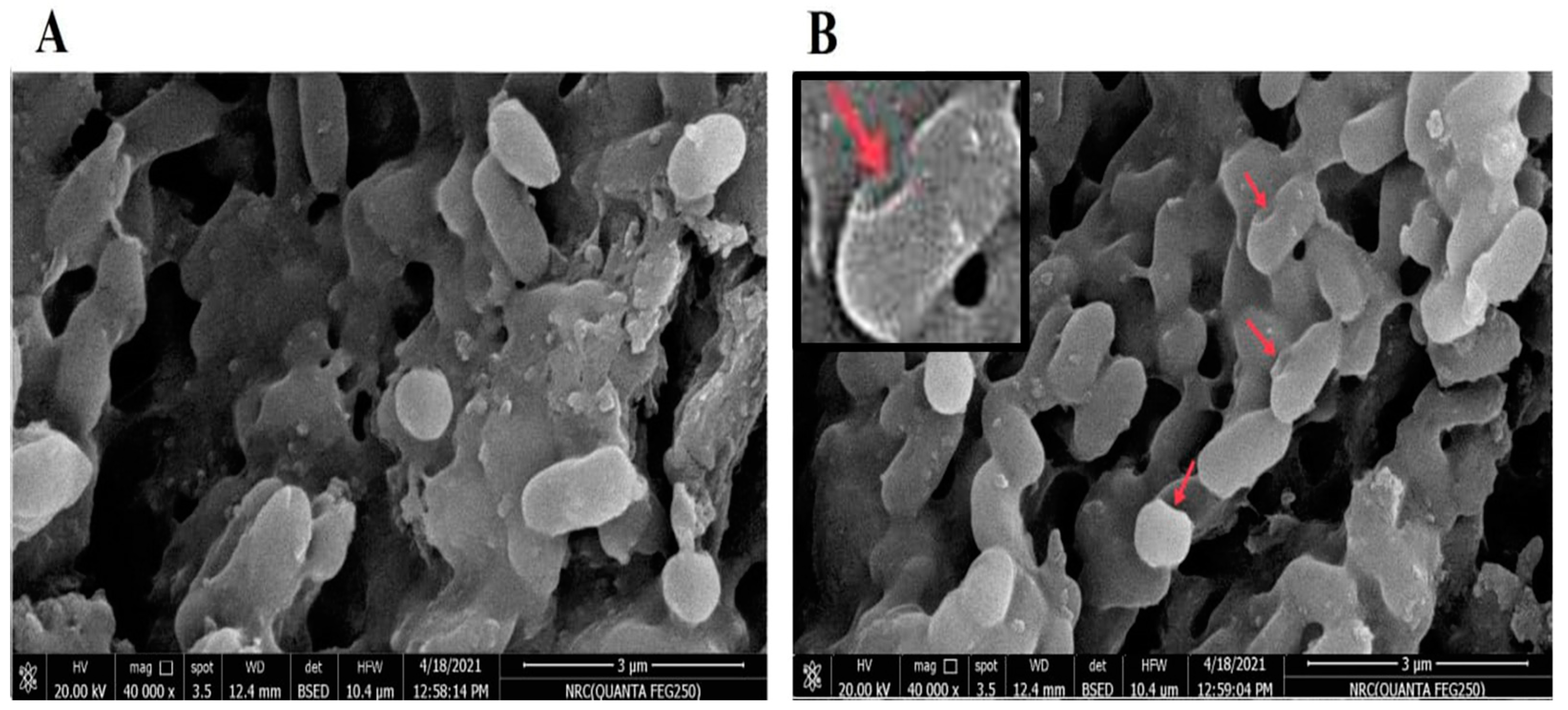
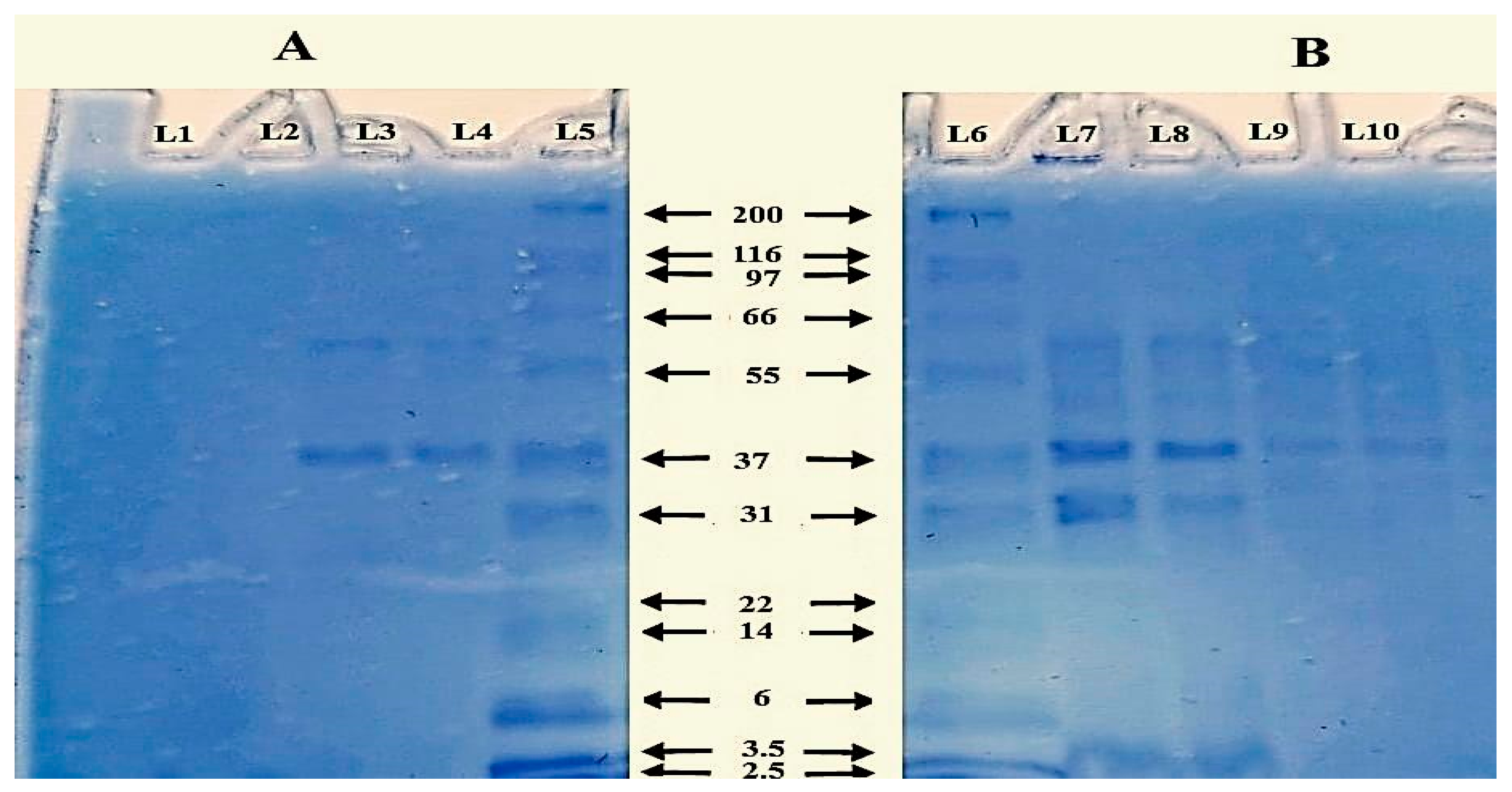
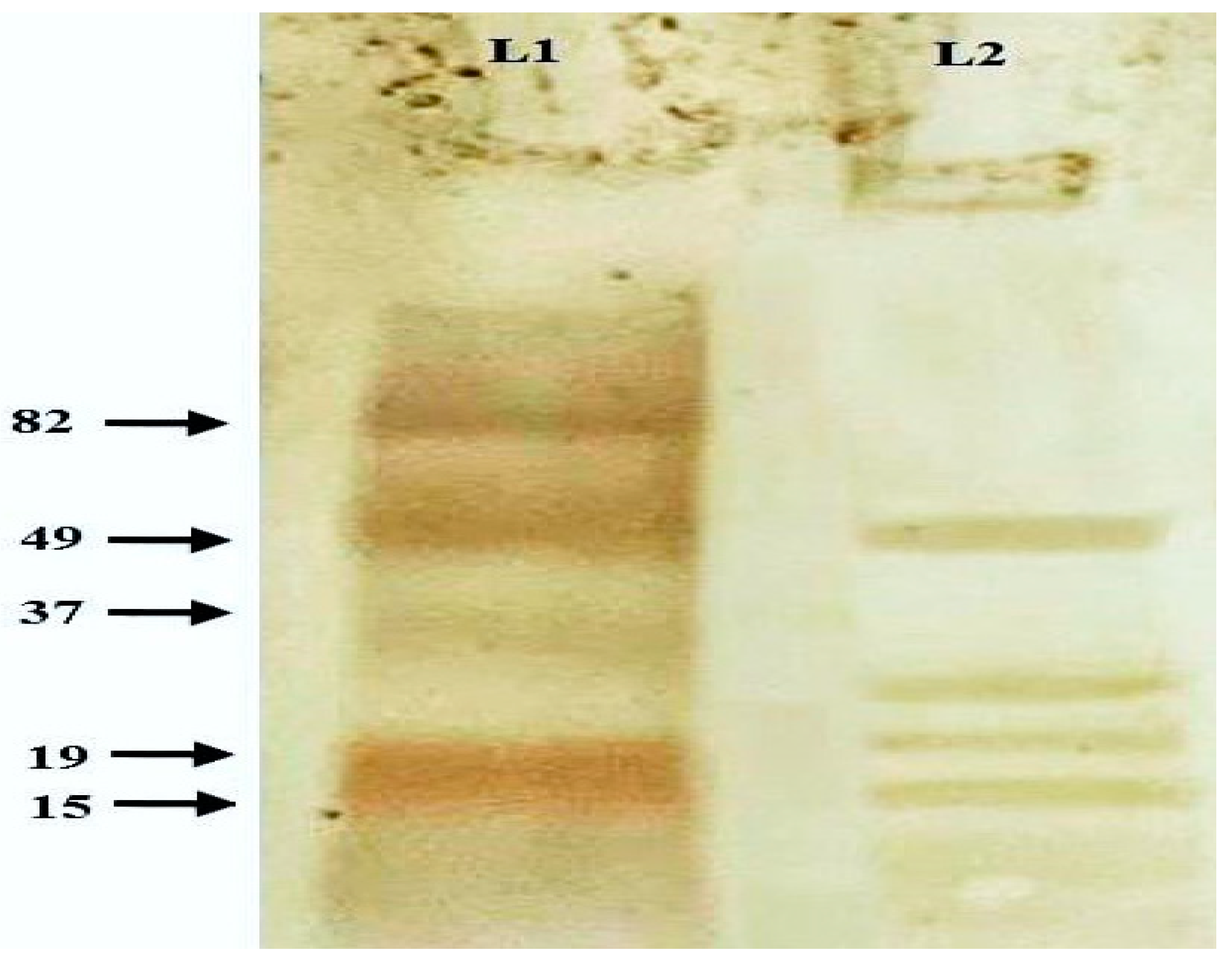
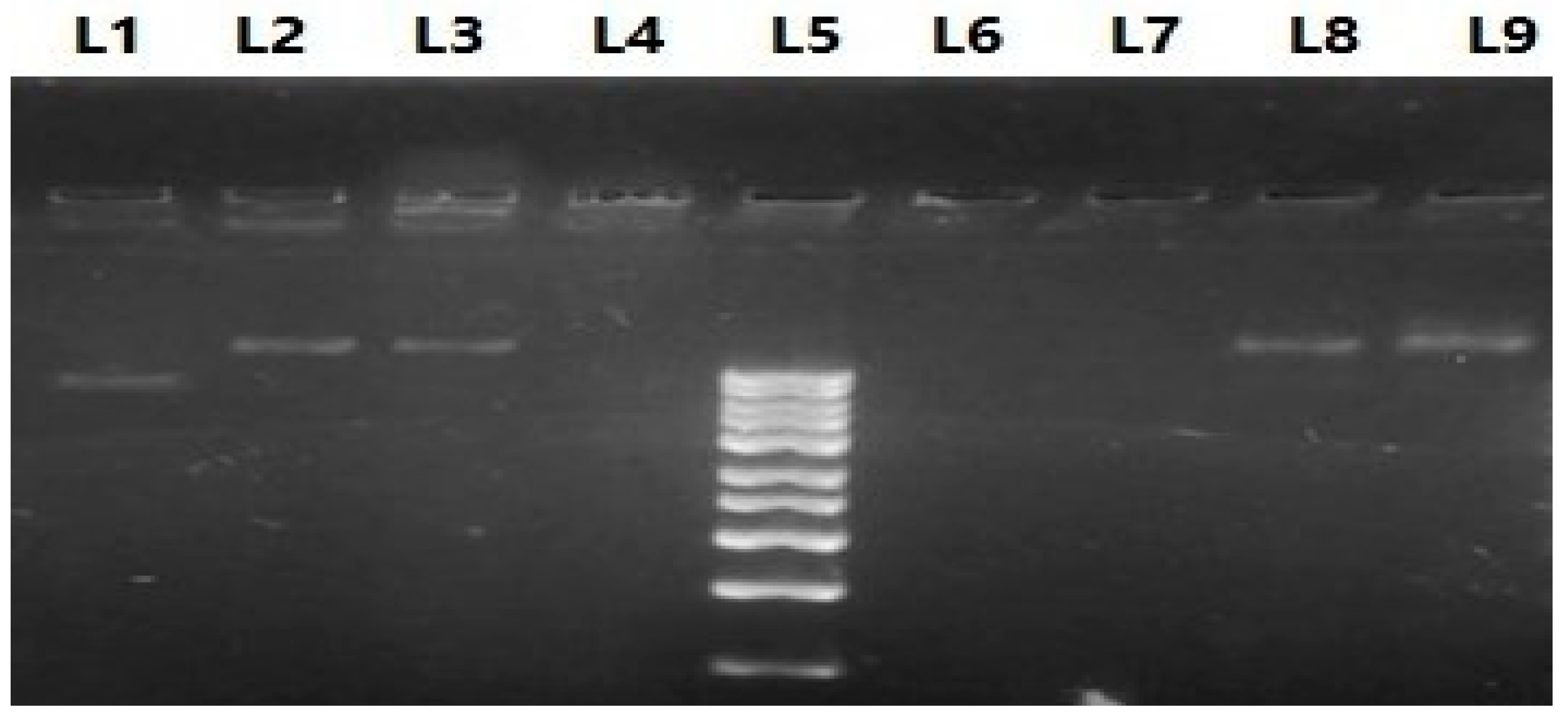

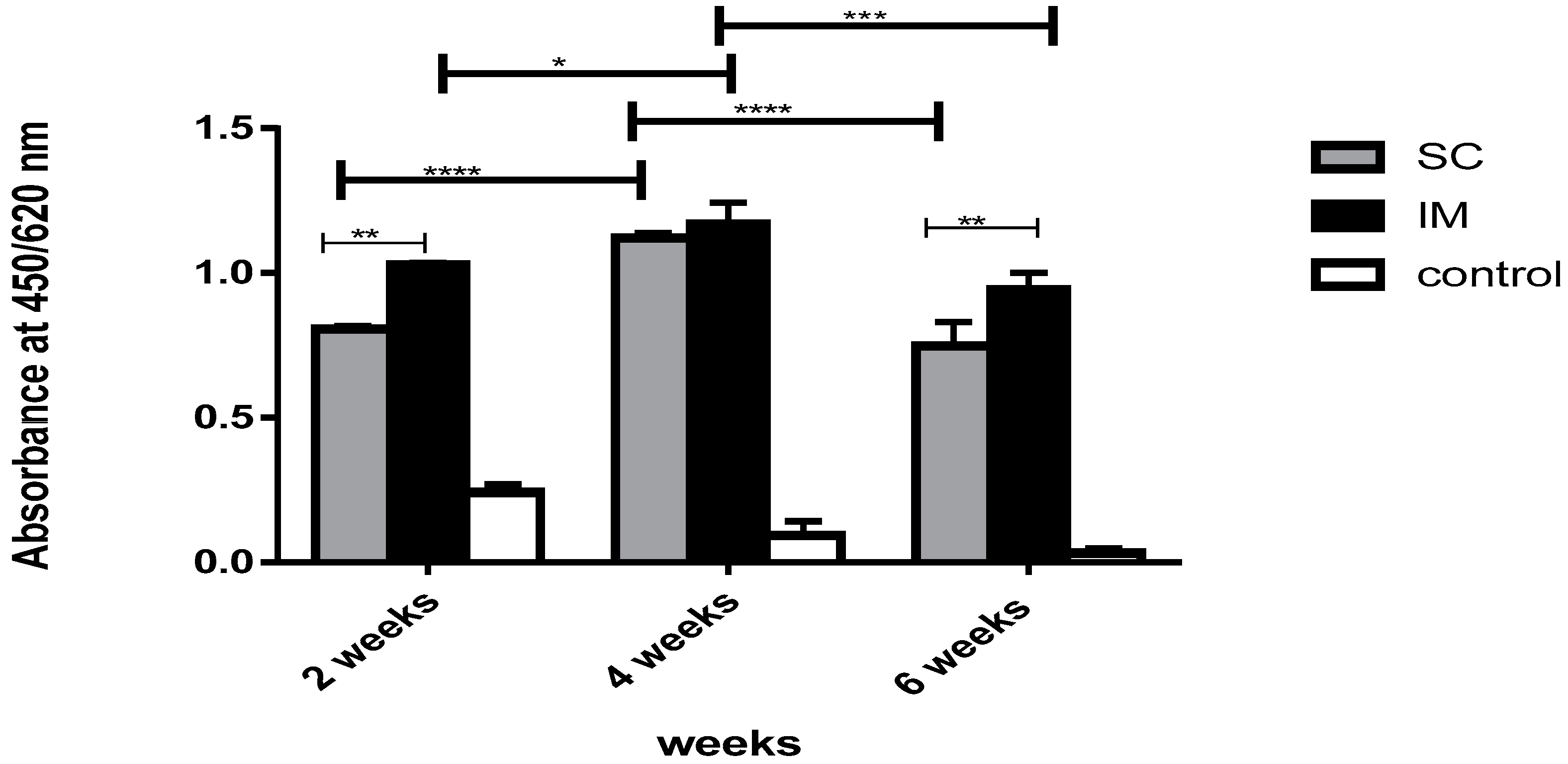



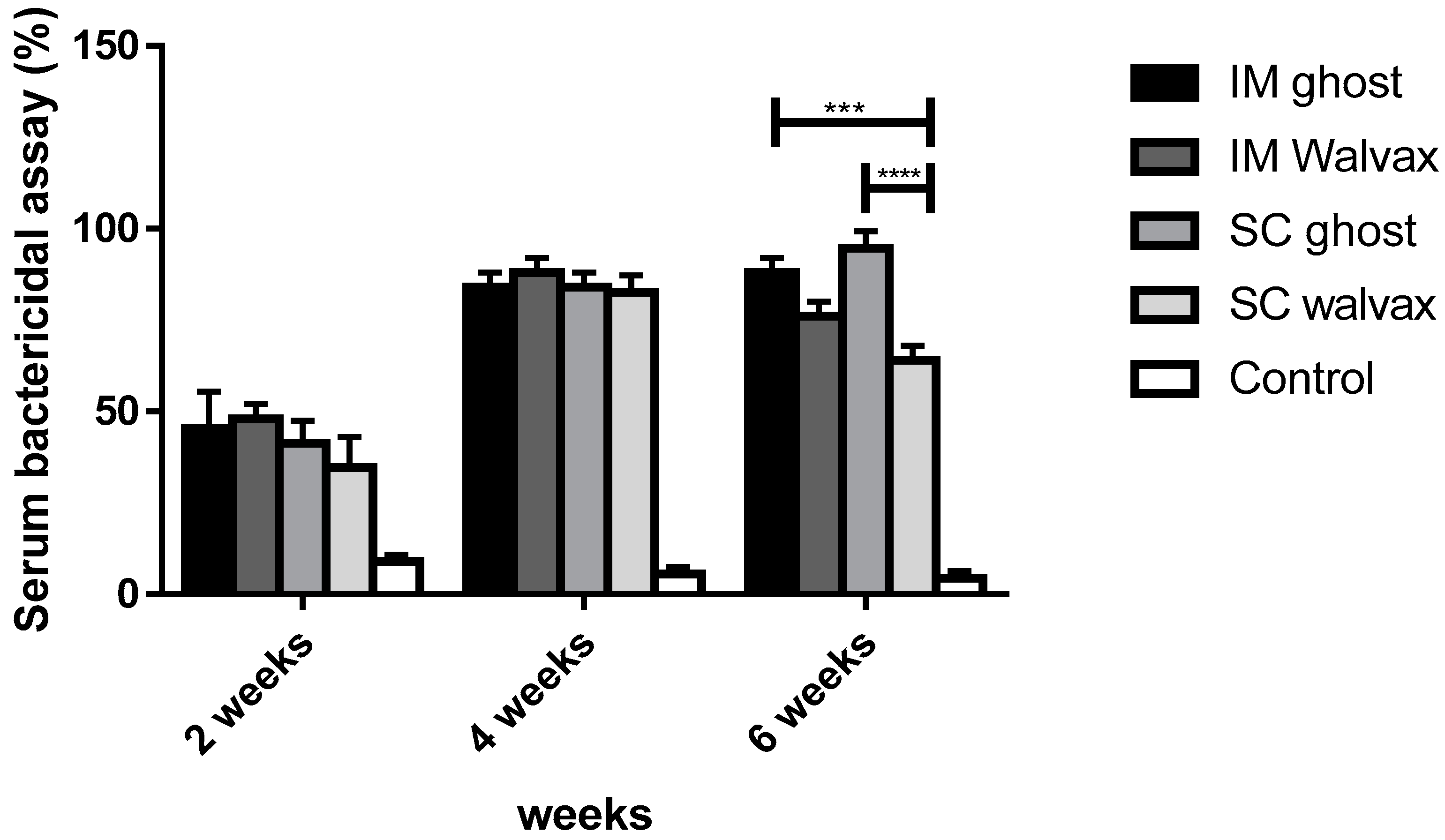
Disclaimer/Publisher’s Note: The statements, opinions and data contained in all publications are solely those of the individual author(s) and contributor(s) and not of MDPI and/or the editor(s). MDPI and/or the editor(s) disclaim responsibility for any injury to people or property resulting from any ideas, methods, instructions or products referred to in the content. |
© 2022 by the authors. Licensee MDPI, Basel, Switzerland. This article is an open access article distributed under the terms and conditions of the Creative Commons Attribution (CC BY) license (https://creativecommons.org/licenses/by/4.0/).
Share and Cite
Ali, R.H.; Ali, M.E.; Samir, R. Production and Characterization of Bacterial Ghost Vaccine against Neisseria meningitidis. Vaccines 2023, 11, 37. https://doi.org/10.3390/vaccines11010037
Ali RH, Ali ME, Samir R. Production and Characterization of Bacterial Ghost Vaccine against Neisseria meningitidis. Vaccines. 2023; 11(1):37. https://doi.org/10.3390/vaccines11010037
Chicago/Turabian StyleAli, Randa H., Mohamed E. Ali, and Reham Samir. 2023. "Production and Characterization of Bacterial Ghost Vaccine against Neisseria meningitidis" Vaccines 11, no. 1: 37. https://doi.org/10.3390/vaccines11010037




